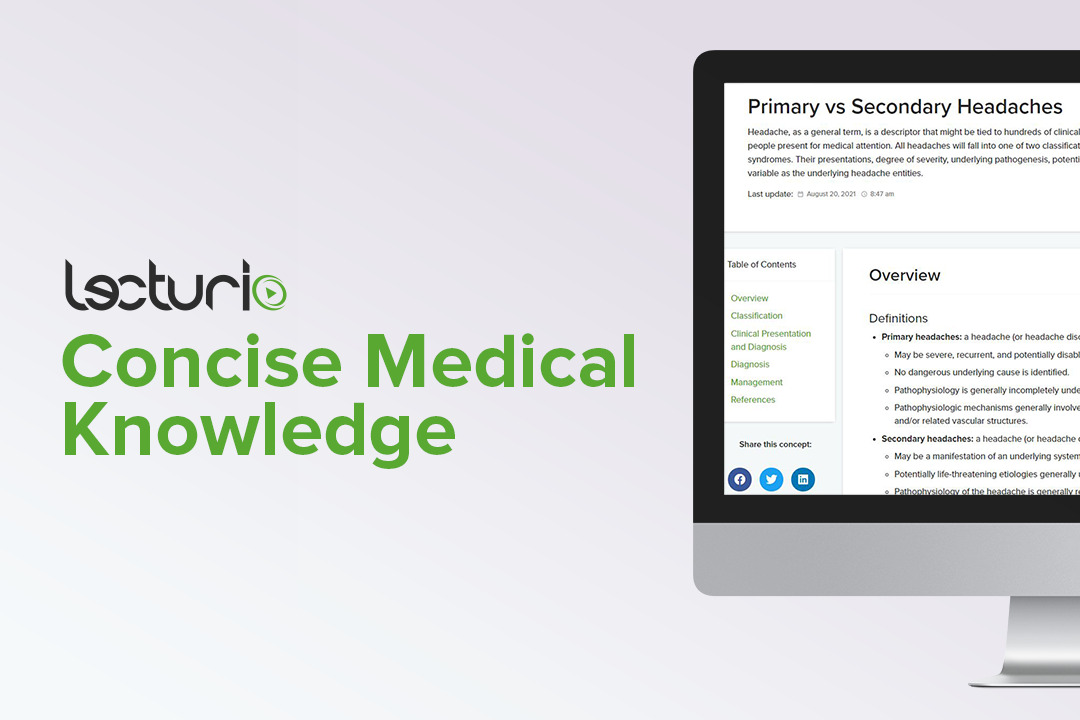Playlist
Show Playlist
Hide Playlist
Introduction to Headaches: Groups and 3-Step-Evaluation System
-
Slides Headaches Introduction to Headaches.pdf
-
Download Lecture Overview
00:01 In this lecture we're going to learn about headache. 00:04 This is a really important lecture that will be important for case vignettes, for seeing patients in the clinic or on the in-patient hospital rounds, and maybe, even for seeing family members and others at reunions. 00:16 A really common topic that is important to understand, and I'll be honest, I often get headache just thinking about all of the causes of headache, and there are many. 00:27 Glaucoma can cause a headache, trigeminal neuralgia, cluster headache, SUNCT, short-acting unilateral neuralgiform headache with conjunctival injection and tearing, it's even a mouthful to say. 00:40 Chronic daily headaches, rebound headache, brain abscesses, primary stabbing headache, paroxysmal hemicrania, obstructive sleep apnea, brain tumor, familial hemiplegic migraine, giant cell arteritis, pseudotumor cerebri. 00:55 Cervicogenic headache, post lumbar puncture headache. 00:59 Migraine, thunderclap headache, tension type, postural headache, subarachnoid hemorrhage, occipital neuralgia, hemicranias continua, meningitis, SUNA, kind of like SUNCT, short-acting unilateral neuralgiform headache with autonomic features, and trigeminal autonomic cephalalgias or the TACs. 01:22 This is only a small list of the many things that can cause headache and it's dizzying. 01:27 It's really hard to understand how to apply this to a clinical vignette or to a patient who may be coming into the clinic. 01:35 So in this lecture, we're going to deconstruct these many potential diagnoses or causes of headache, and understand how to categorize them, how to start the patient evaluation or approach a clinical vignette, and those are things we can use to learn each of the individual types of headache that you see here. 01:52 So when I'm thinking about headache, I like to think about the questions that I'm going to ask the patient in the clinic to figure out what the cause of the headache is. 02:02 And I tend to categorize headaches into five or six or maybe seven buckets, seven types of questions that I ask a patient to understand the category of headache that I'm going to focus on. And here, we'll present those. 02:15 The first question and the first group of conditions that I want to look for are emergent causes of headache, and those are the thunderclap or the emergency headaches. 02:25 And we'll walk through the questions that I ask patients to dive in on and drive into the emergent causes of a headache. 02:33 The second group of conditions and questions that I'll ask patients drive at headaches with vision disturbances, and there are a number of headaches that also present with prominent vision disturbances and we'll look at those. 02:46 The third category of headaches or group of headaches are neuralgiform headaches and we can ask questions to get at the character of the head pain and look at this category of neuralgiform headaches. 02:59 The fourth category and group of headaches are pressure headaches, high pressure headaches and low pressure headaches, and we'll ask questions to try and understand whether we may be dealing with a high or a low pressure headache phenomenon. 03:12 And if it's not an emergent or a headache with visual disturbances, neuralgiform or pressure type headache, typically we're dealing with a paroxysmal headache, a chronic recurrent headache that may come from a number of causes or maybe those causes maybe unknown and we'll talk about the types of questions we'll ask in groups of conditions we'll put in that paroxysmal headache bucket. 03:34 So this is a good way to categorize all those causes of headache into something that we can use on a clinical vignette or when we're evaluating patients. 03:42 And we can look at this in steps, and clinically we tend to take three steps when we're evaluating a headache patient. 03:49 So these are the things we do with every headache patient that comes in the clinic. 03:54 The first is we got to figure out whether this is a primary headache syndrome or a secondary headache syndrome. 03:59 The second is we need to think about whether we need imaging, evaluation or additional interventional now to manage this patient. 04:06 And then, the third step is to figure out how we're going to treat the patient and treat this cause of headache. 04:12 So let's walk through each of these steps that we take with patients.
About the Lecture
The lecture Introduction to Headaches: Groups and 3-Step-Evaluation System by Roy Strowd, MD is from the course Headache.
Included Quiz Questions
Which type of headache is considered an emergency?
- Thunderclap headache
- Tension headache
- Migraine headache
- Low-pressure headache
- Cluster headache
What is a paroxysmal headache?
- A chronic, recurrent headache due to known or unknown causes
- A headache related to cardiac arrhythmias
- A headache that lasts several days
- A headache due to an infectious cause such as meningitis
- A headache due to a malignant process
Customer reviews
5,0 of 5 stars
| 5 Stars |
|
5 |
| 4 Stars |
|
0 |
| 3 Stars |
|
0 |
| 2 Stars |
|
0 |
| 1 Star |
|
0 |





